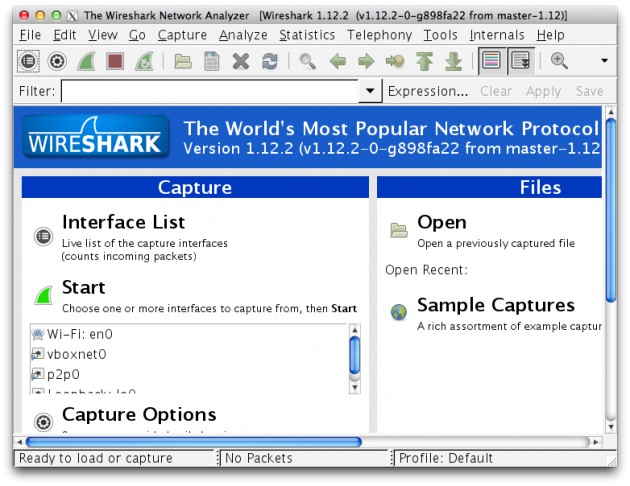
Also, a fair amount of traffic is generated from your own workstation for applications and services that are running in the background, and you had no idea they were creating this much noise. It's a bit amazing just how much background traffic there is on a typical network, such as broadcast packets from devices advertising their names, addresses, and services to and from other devices asking for addresses of stations they want to communicate with. If you don't see this, try a different interface. You'll see a bewildering variety of packets going by in the top section (called the Packet List pane) of the screen this is normal. Wireshark will start capturing all the packets that can be seen from that interface, including the packets sent to and from your workstation. Once you've identified the correct interface, select the checkbox on the left-hand side of that interface and click on the Start button at the bottom of the Capture Interfaces window. If you're still unsure, open a browser window and navigate to one of your favorite websites and watch the packets and packets/s counters to identify the interface that shows the greatest increase in activity. Another possible indicator is if an interface has an IP address assigned and others do not. The most reliable indicator of the active network interface is that it will have greater number of steadily increasing packets with a corresponding active number of packets/s (which will vary over time). If you have a wired local area network connection and the interface is enabled, that's probably the active interface, but you might also have a wireless interface that is enabled and you may or may not be the primary interface. The goal is to identify the active interface that will be used to communicate with the Internet when you open a browser and navigate to a website. However, in most cases, you'll only be interested in capturing packets from a network interface. It can be saved in your disk.On Linux/Unix/Mac platforms, you might also see a loopback interface that can be selected to capture packets being sent between applications on the same machine. – Right click on HTTP request and select ‘Follow TCP Traces” – Now, Wireshark will generate lots of traces, just select HTTP text from ‘Filter’ text box: – Start Wireshark traces with identified network trace (Select Interfaces list and identify your available networks) There are plenty of information available on internet. – It may open X11 application with Wireshark, close both and restart Wireshark again. Browse your folder to “/Applications/Utilities/XQuartz.app/Contents/MacOS/X11” application. – Simple logout/login after installation of xQuartz.

#Wireshark xquartz download
For that you can download XQuartz from here.
#Wireshark xquartz mac
However installing on MAC needs few more steps: Wireshark comes with installation for most of platform. Wireshark does not need any introduction, it is great tool to generate trace for any communication and quite common in software/hardware industry. Just replace your real URL with proxied URL to get TCP trace on command prompt (Terminal). You need to provide remote host and remote port information to script. Now, just start your proxy using following simple command. Java -cp grinder/grinder.jar -Xms16m -Xmx32m -localhost localhost -localport 9090 -remotehost $1 -remoteport $2 Just download Grinder proxy in any folder and create a sample script having following command to quick start your proxy: Grinder is generally used for load testing however it is quite handy for traffic routing and TCP proxy. Primarily my communication protocol is HTTP, however traces can be generated for any protocol. TCP tracing helps to compare request and response of success and failed TCP traces to identify issues in network calls. TCP trace helps solving several issues whether application logger is enabled or not. These days when applications are becoming more and more service oriented, finding issue in between layers is tricky and cumbersome.


 0 kommentar(er)
0 kommentar(er)
